fuel Peugeot 3008 Hybrid 4 2014 Owner's Manual
[x] Cancel search | Manufacturer: PEUGEOT, Model Year: 2014, Model line: 3008 Hybrid 4, Model: Peugeot 3008 Hybrid 4 2014Pages: 378, PDF Size: 22.5 MB
Page 4 of 378
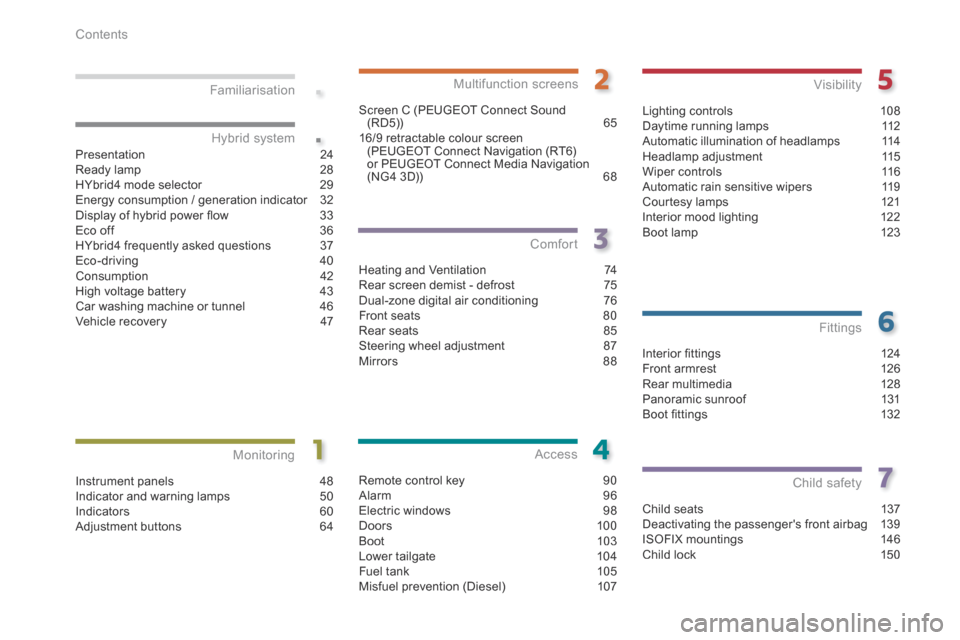
.
.
Contents
Interior fi ttings 124Front armrest 126Rear multimedia 128Panoramic sunroof 131Boot fi ttings 132
Fittings
Child seats 137Deactivating the passenger's front airbag 139ISOFIX mountings 146Child lock 150
Child safetyInstrument panels 48Indicator and warning lamps 50Indicators 60Adjustment buttons 64
Monitoring
Familiarisation
Screen C (PEUGEOT Connect Sound (RD5))
6516/9 retractable colour screen (PEUGEOT Connect Navigation (RT6) or PEUGEOT Connect Media Navigation (NG4 3D)) 68
Multifunction screens
Heating and Ventilation 74Rear screen demist - defrost 75Dual-zone digital air conditioning 76Front seats 80Rear seats 85Steering wheel adjustment 87Mirrors 88
Comfort
Remote control key 90Alarm 96Electric windows 98Doors 10 0Boot 103Lower tailgate 104Fuel tank 105Misfuel prevention (Diesel) 107
Access
Lighting controls 108Daytime running lamps 112Automatic illumination of headlamps 114Headlamp adjustment 115Wiper controls 116Automatic rain sensitive wipers 119Courtesy lamps 121Interior mood lighting 122Boot lamp 123
Visibility
Presentation 24Ready lamp 28HYbrid4 mode selector 29Energy consumption / generation indicator 32Display of hybrid power fl ow 33Eco off 36HYbrid4 frequently asked questions 37Eco-driving 40Consumption 42High voltage battery 43Car washing machine or tunnel 46Vehicle recovery 47
Hybrid system
Page 5 of 378
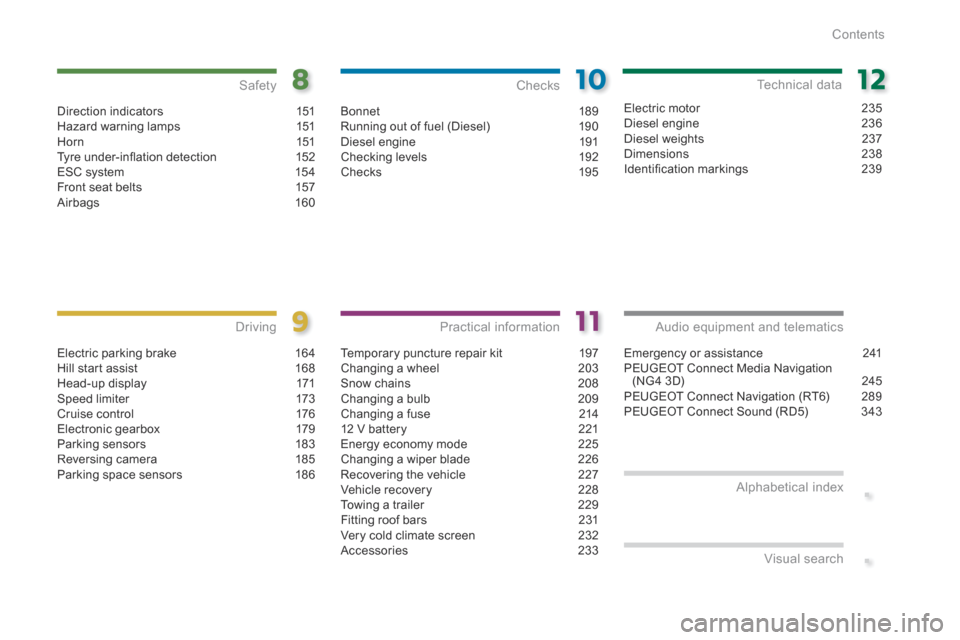
.
.
Contents
Direction indicators 151Hazard warning lamps 151H o r n 151Tyre under-infl ation detection 152ESC system 154Front seat belts 157Airbags 160
Safety
Electric parking brake 164Hill start assist 168Head-up display 171Speed limiter 173Cruise control 176Electronic gearbox 179Parking sensors 183Reversing camera 185Parking space sensors 186
Driving
Emergency or assistance 241PEUGEOT Connect Media Navigation (NG4 3D) 245PEUGEOT Connect Navigation (RT6) 289PEUGEOT Connect Sound (RD5) 343
Audio equipment and telematics
Alphabetical indexVisual search
Bonnet 189Running out of fuel (Diesel) 190Diesel engine 191Checking levels 192Checks 195
Checks
Temporary puncture repair kit 197Changing a wheel 203Snow chains 208Changing a bulb 209Changing a fuse 21412 V battery 221Energy economy mode 225Changing a wiper blade 226Recovering the vehicle 227Vehicle recovery 228Towing a trailer 229Fitting roof bars 231Very cold climate screen 232Accessories 233
Practical information
Electric motor 235Diesel engine 236Diesel weights 237Dimensions 238Identifi cation markings 239
Technical data
Page 7 of 378
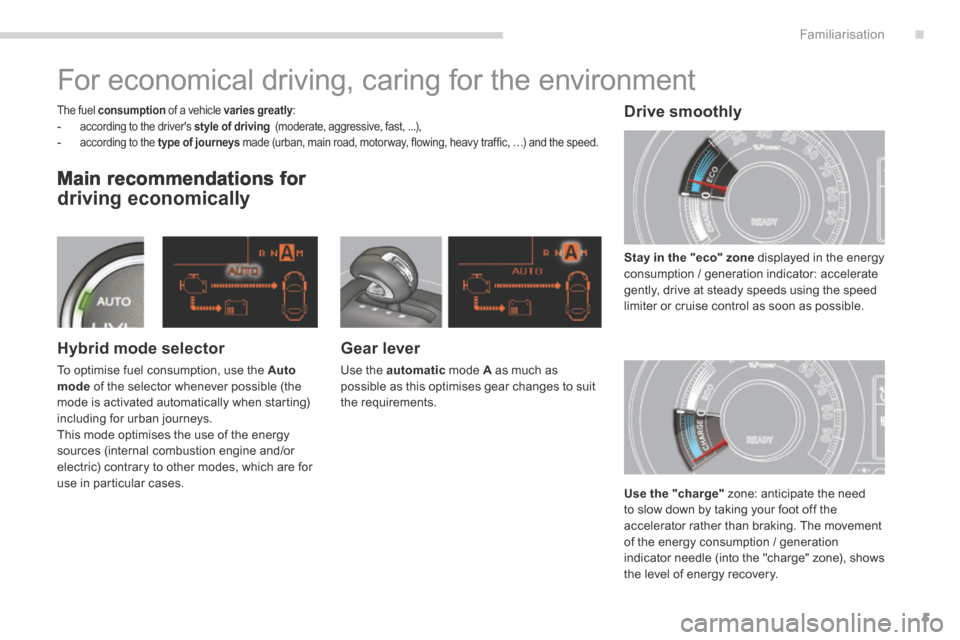
.Familiarisation5
Main recommendations for
driving economically
Gear lever
Use the automatic mode A as much as possible as this optimises gear changes to suit the requirements.
The fuel consumption of a vehicle varies greatly : varies greatly : varies greatly - according to the driver's style of driving (moderate, aggressive, fast, ...), - according to the type of journeys made (urban, main road, motor way, flowing, heavy traffic, …) and the speed.
Hybrid mode selector
To optimise fuel consumption, use the Automode of the selector whenever possible (the mode is activated automatically when starting) including for urban journeys. This mode optimises the use of the energy sources (internal combustion engine and/or electric) contrary to other modes, which are for use in particular cases.
Stay in the "eco" zone displayed in the energy consumption / generation indicator: accelerate gently, drive at steady speeds using the speed limiter or cruise control as soon as possible.
Use the "charge" zone: anticipate the need to slow down by taking your foot off the accelerator rather than braking. The movement
of the energy consumption / generation indicator needle (into the "charge" zone), shows the level of energy recovery.
Drive smoothly
For economical driving, caring for the environment
Page 10 of 378
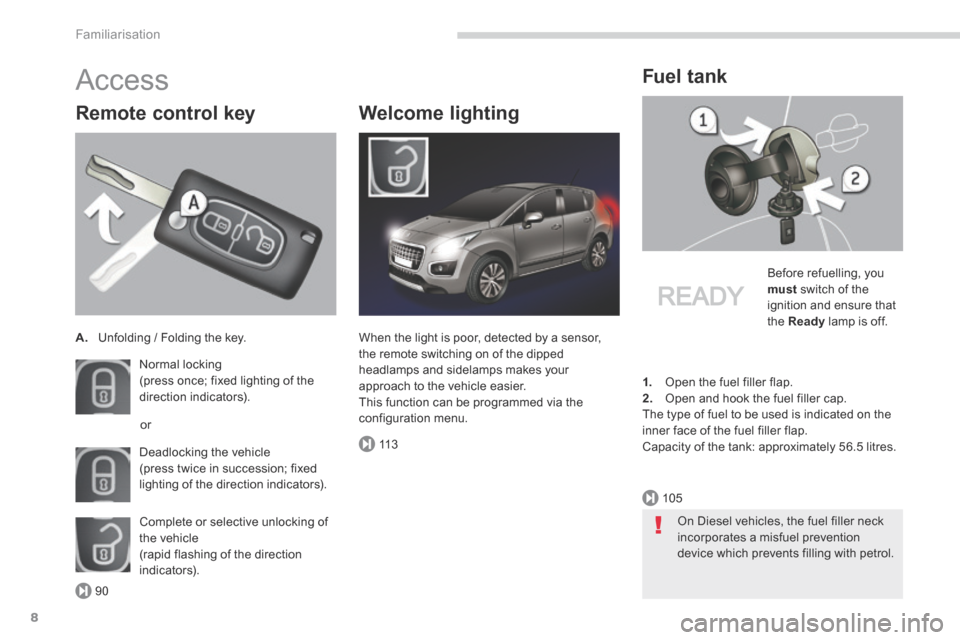
90
105
11 3
Familiarisation
8
Access
Remote control key
A. Unfolding / Folding the key.
Normal locking (press once; fixed lighting of the direction indicators).
Deadlocking the vehicle (press twice in succession; fixed lighting of the direction indicators).
Complete or selective unlocking of the vehicle (rapid flashing of the direction i n di c ato r s).
or
When the light is poor, detected by a sensor, the remote switching on of the dipped headlamps and sidelamps makes your approach to the vehicle easier. This function can be programmed via the configuration menu.
Fuel tank
Before refuelling, you must switch of the ignition and ensure that the Ready lamp is off.
1. Open the fuel filler flap. 2. Open and hook the fuel filler cap. The type of fuel to be used is indicated on the
inner face of the fuel filler flap. Capacity of the tank: approximately 56.5 litres.
Welcome lighting
On Diesel vehicles, the fuel filler neck incorporates a misfuel prevention device which prevents filling with petrol.
Page 19 of 378
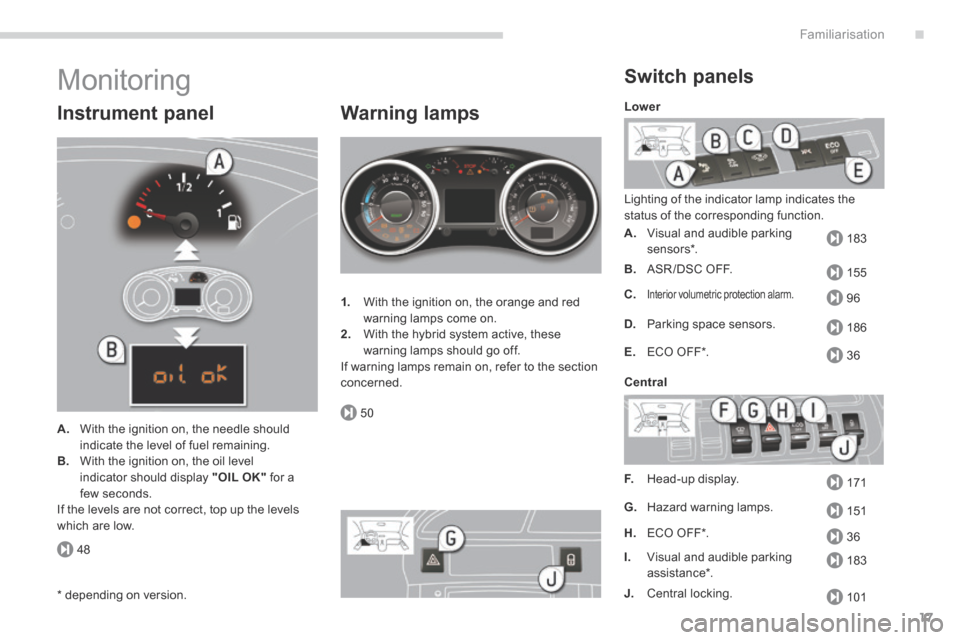
.
48
183
155
96
186
36
171
151
36
183
50
101
Familiarisation17
Monitoring
Instrument panel
A. With the ignition on, the needle should
indicate the level of fuel remaining. B. With the ignition on, the oil level indicator should display "OIL OK" for a few seconds. If the levels are not correct, top up the levels which are low.
Warning lamps
1. With the ignition on, the orange and red warning lamps come on. 2. With the hybrid system active, these warning lamps should go off. If warning lamps remain on, refer to the section concerned.
Switch panels
Lighting of the indicator lamp indicates the status of the corresponding function.
Lower
Central
A. Visual and audible parking sensors * .
B. ASR /DSC OFF.
C.Interior volumetric protection alarm.
D. Parking space sensors.
E. ECO OFF * .
F. Head-up display.
G. Hazard warning lamps.
H. ECO OFF * .
I. Visual and audible parking assistance * .
J. Central locking. * depending on version.
Page 28 of 378
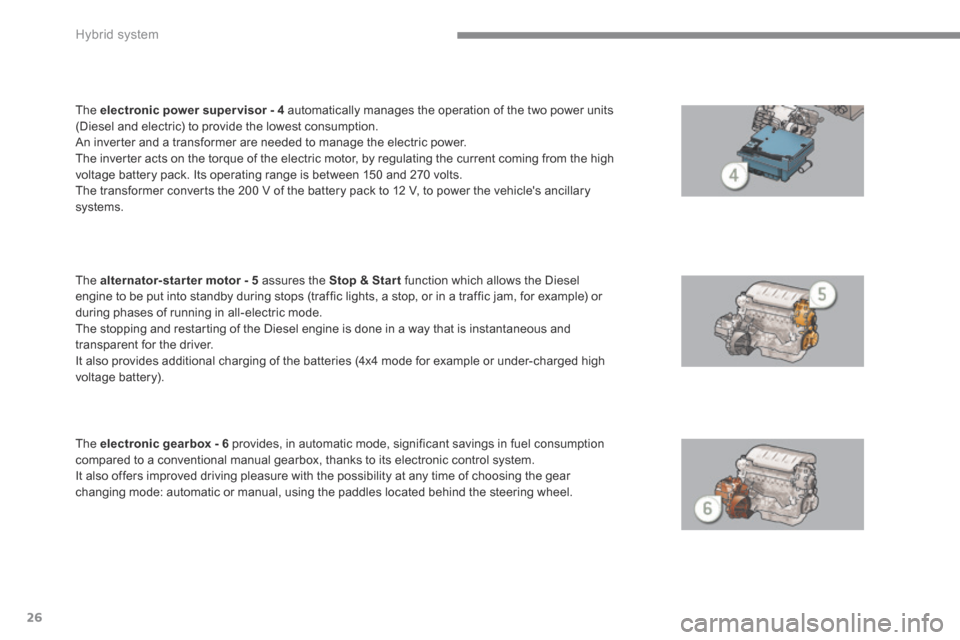
Hybrid system
26
The electronic power super visor - 4 automatically manages the operation of the two power units (Diesel and electric) to provide the lowest consumption. An inverter and a transformer are needed to manage the electric power. The inverter acts on the torque of the electric motor, by regulating the current coming from the high voltage battery pack. Its operating range is between 150 and 270 volts. The transformer converts the 200 V of the battery pack to 12 V, to power the vehicle's ancillary systems.
The alternator-starter motor - 5 assures the Stop & Star t function which allows the Diesel engine to be put into standby during stops (traffic lights, a stop, or in a traffic jam, for example) or during phases of running in all-electric mode. The stopping and restarting of the Diesel engine is done in a way that is instantaneous and transparent for the driver. It also provides additional charging of the batteries (4x4 mode for example or under-charged high voltage battery).
The electronic gearbox - 6 provides, in automatic mode, significant savings in fuel consumption compared to a conventional manual gearbox, thanks to its electronic control system. It also offers improved driving pleasure with the possibility at any time of choosing the gear changing mode: automatic or manual, using the paddles located behind the steering wheel.
Page 31 of 378
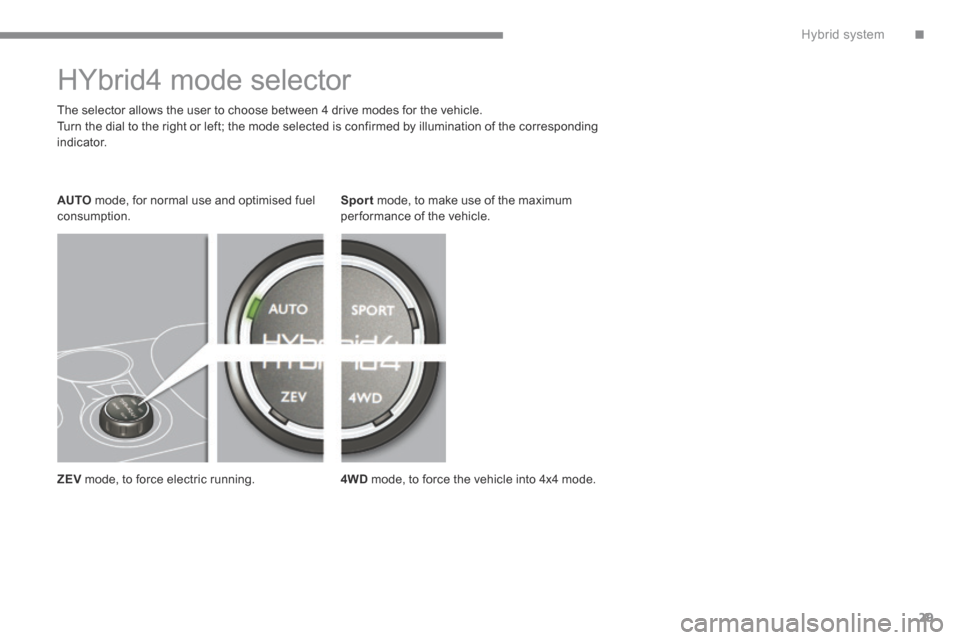
.Hybrid system29
HYbrid4 mode selector
The selector allows the user to choose between 4 drive modes for the vehicle. Turn the dial to the right or left; the mode selected is confirmed by illumination of the corresponding i n d i c a t o r.
ZEV mode, to force electric running.
Sport mode, to make use of the maximum per formance of the vehicle.
4WD mode, to force the vehicle into 4x4 mode.
AUTO mode, for normal use and optimised fuel consumption.
Page 32 of 378
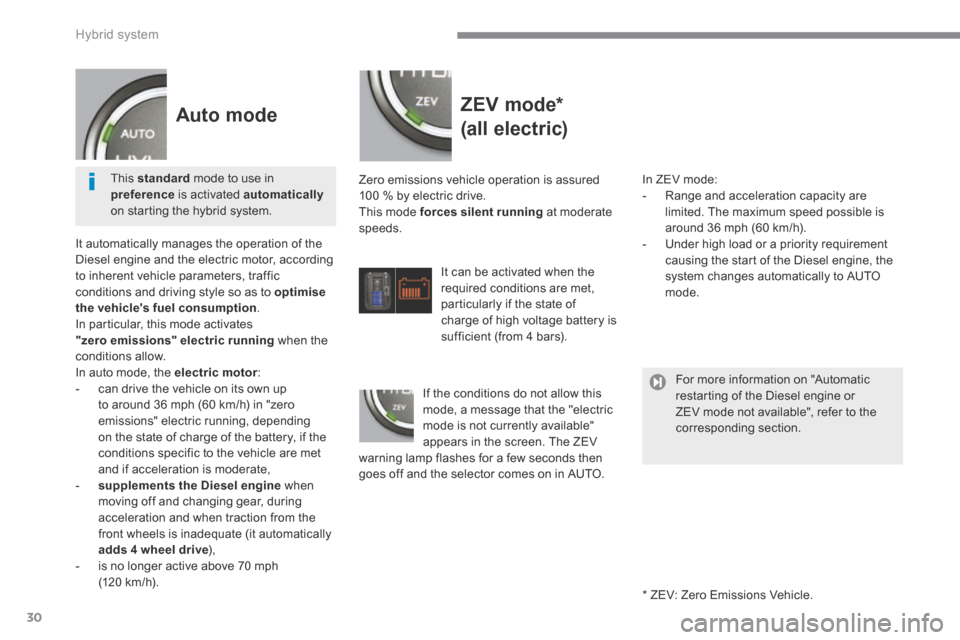
Hybrid system
30
ZEV mode *
(all electric)
Zero emissions vehicle operation is assured 100 % by electric drive. This mode forces silent running at moderate speeds.
* ZEV: Zero Emissions Vehicle.
In ZEV mode: - Range and acceleration capacity are limited. The maximum speed possible is around 36 mph (60 km/h). - Under high load or a priority requirement causing the start of the Diesel engine, the system changes automatically to AUTO mode.
It can be activated when the required conditions are met, particularly if the state of charge of high voltage battery is sufficient (from 4 bars).
If the conditions do not allow this mode, a message that the "electric mode is not currently available" appears in the screen. The ZEV warning lamp flashes for a few seconds then goes off and the selector comes on in AUTO.
Auto mode
It automatically manages the operation of the Diesel engine and the electric motor, according to inherent vehicle parameters, traffic conditions and driving style so as to optimise the vehicle's fuel consumption . In particular, this mode activates "zero emissions" electric running when the conditions allow. In auto mode, the electric motor : - can drive the vehicle on its own up to around 36 mph (60 km/h) in "zero emissions" electric running, depending on the state of charge of the battery, if the conditions specific to the vehicle are met and if acceleration is moderate, - supplements the Diesel engine when moving off and changing gear, during acceleration and when traction from the front wheels is inadequate (it automatically adds 4 wheel drive ), - is no longer active above 70 mph ( 1 2 0 k m / h ) .
This standard mode to use in preference is activated automaticallyon starting the hybrid system.
For more information on "Automatic restarting of the Diesel engine or ZEV mode not available", refer to the corresponding section.
Page 37 of 378

.Hybrid system35
The internal combustion engine may restart or ZEV mode may not be available in the various conditions presented below. The internal combustion engine can be switched off automatically as soon as these conditions are lifted. When the conditions described below cause the vehicle to come out of ZEV mode and the Diesel engine to restart, the vehicle automatically changes to AUTO mode.
Action by the driver
- Moving the gear selector to position M . - Action on steering mounted control paddles to change gear. - Sustained and sharp acceleration. - Use of demisting. - Use of air conditioning.
- If the high voltage battery is not sufficiently charged. A minimum of 4 bars in ZEV mode so as to ensure operation over a certain distance (in AUTO, electric operation is accessible for a shorter period with a lower level of charge). - When the fuel level enters the reserve zone (where rate of consumption of this reserve is high, ZEV inhibition may continue for some time after refuelling). - During regeneration of the particle emissions filter, which occurs automatically for 5 to 10 minutes, approximately every 300 miles (500 kms) (or less in extended urban running).
Diffi cult weather conditions and circumstances
- If certain conditions or engine temperature requirements make it necessary (such as an engine temperature that is too low for the ambient conditions). - When the battery is close to maximum charge (for example: when going down a long hill), because engine recovery being no longer possible, the internal combustion engine restarts automatically just to provide engine braking. - If the vehicle encounters a steep slope (car park ramp, ...). - If the vehicle has been parked in the sun for a prolonged period. - When driving in mountainous conditions (altitude).
Automatic restarting of the Diesel engine or ZEV mode NOT available
Your vehicle is fitted with the most effective emissions control systems, in particular the Particle Emissions Filter (PEF). At regular intervals your Diesel engine will produce energy for the self-cleaning of this f i l t e r. During this PEF regeneration phase, electric running is purposely made
unavailable and is accompanied by a message " Electric mode not available: PEF regeneration in progress ".
Maintaining the performance of the system
- When the vehicle exceeds 18 mph (30 km/h) after moving off (if the internal combustion engine has not already started since the vehicle was last started).
Page 40 of 378

Hybrid system
38
Reducing consumption - Fuel
QuestionAnswer
How can I optimise my fuel consumption? Give preference to Auto mode as it selects in the best way the "driving energy source" to use in order to reduce fuel consumption. You should also adapt your driving style to the characteristics of hybrid vehicles to get the best out of it, for example by taking your foot off the accelerator pedal rather than braking and by anticipating decelerations (entering a built-up area, stop at traffic lights, stop at halt signs, ...).
Why do I not manage to reduce my fuel consumption even though I often drive in ZEV (Zero Emissions Vehicle) mode?
It is not ZEV mode but Auto mode that is the most appropriate for reducing fuel consumption, as it selects the best "driving energy source". ZEV mode (100% electric operation) can reduce fuel consumption in some cases. However, recharging the traction battery has an energy cost. This is why we recommend using Auto mode more often.
Why does the trip computer sometimes display the bars for 28 mpg (10 litres) consumption in town?
The current fuel consumption displayed may appear high when the distance covered is very low, but this generally has very little impact and the true average fuel consumption will remain low. In town, your hybrid retains very good fuel economy (of the order of 35% better than a non-hybrid vehicle).
Why is my battery rarely fully charged? A partly charged battery is normal operation (4 to 5 bars on average in Auto mode). This allows some capacity to be left free for the recovery for energy when going downhill or taking when your foot off the accelerator.
Why are there so may fuel alert messages when starting to use the reserve? To encourage you to refuel as soon as possible and avoid the loss of hybrid functions.